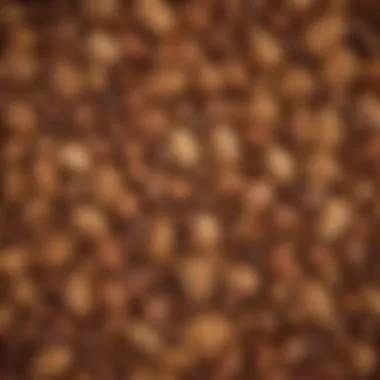Discovering Low-Carb and Low-Sodium Snack Choices


Intro
In today's fast-paced world, healthy snacking options can often feel elusive. Many individuals face barriers like busy schedules, cravings for convenience, and a flood of unhealthy choices. It's easy, therefore, to overlook the essential task of making nourishing decisions. Exploring low-carb and low-sodium snacks enhances dietary balance and alleviates common health concerns like high blood pressure and excess weight.
Recipe Overview
- Crispy Chickpea Snack
- Number of Portions: 4
- Time Required: 30 minutes (includes prep and cooking)
- Difficulty: Easy
- Main Ingredients:
- Canned chickpeas
- Olive oil
- Paprika
- Salt (low sodium)
Crispy chickpea snacks provide a satisfying crunch while aligning well within low-carb and low-sodium constraints. Packed with protein and fiber, you're opting for an aggressively nutritious alternative to typical savory snacks.
Step-by-Step Instructions
Preparing the Ingredients:
- Rinse a can of chickpeas under cold water, and drain it.
- Pat the chickpeas dry using a clean kitchen towel or paper towels. The drier the chickpeas, the better they crisp up in the oven.
- Transfer the chickpeas into a bowl; drizzle olive oil and sprinkle paprika over them.
Cooking Instructions:
- Preheat your oven to 400°F (200°C).
- Spread the seasoned chickpeas evenly on a baking sheet lined with parchment paper.
- Bake the chickpeas for about 25 minutes, shaking the pan halfway through to ensure even cooking.
- Once they are golden brown and crunchy, remove from the oven and cool slightly.
- Apply a light sprinkle of low-sodium salt to taste before serving.
Time-Saving Strategies:
- Ensure chickpeas are dried adequately to reduce cooking time.
- Consider using canned chickpeas instead of dried for fast preparation.
Nutritional Information
Per Portion Estimation (1/4 recipe):
- Total Calories: 120
- Protein: 6g
- Carbohydrates: 18g
- Fats: 3g
Beneficial Nutrients:
- Fiber: 6g
- Iron: 2mg
- Folate: 15% of daily value
Quick Cooking Tips
- Utilize an air fryer to accomplish the same crispy texture while saving energy.
- When cooking, try to multitask on other meal preparations. Dicing vegetables or prepping dips can lend deeper utility to your cooking effort.
- Experiment with various spices like cumin or garlic powder for added flavor.
Related Recipes & Variations
- Spiced Almonds: Toss almonds in olive oil and your choice of spices before toasting for a crunchy treat.
- Cucumber Hummus Bites: Use cucumber slices topped with low-carb hummus for a light snack.
These derivative recipes keep in line with the focus on low-carb and low-sodium snacks while offering variety to your meals. Sharing your personalized takes on these recipes can foster valuable discussions around healthy cooking, whether on platforms like Reddit, Facebook, or other avenues.
More efficient snack planning can be a game-changer for culinary enthusiasts wanting simplified approaches to healthy eating.
Prolusion to Low-Carb and Low-Sodium Snacks
Low-carb and low-sodium snacks are gaining attention, especially among health-conscious individuals. This rise is due not just to attention to weight management and hypertension but also to the overall desire for better nutrition. The modern world is fast-paced, and many seek quick, convenient snack options that support their health goals without compromising flavor or satisfaction.
Defining Low-Carb and Low-Sodium
When we talk about low-carb diets, we refer to consuming fewer carbohydrates than what is typically recommended. This can mean reducing the intake of starchy foods, sugary snacks, and refined grains. On the other hand, low-sodium snacks involve limiting salt usage in food preparation and choosing those with naturally low sodium. A snack categorized in both realms would typically consist of vegetables, proteins, and healthy fats while avoiding processed ingredients that contribute excess carbs and sodium.
The Health Benefits of Low-Carb and Low-Sodium Snacks
The advantages of incorporating low-carb and low-sodium snacks into one's diet are multifaceted. Research shows that reducing carbohydrate intake can lead to weight loss and improved blood sugar control. This might also lower the risk of developing mind ens insecurity concerning food cravings.


Additionally, lowering sodium may help maintain healthy blood pressure levels, which is particularly significant for individuals with hypertension or those at risk for heart disease.
Incorporating these snack options not only aligns with healthier lifestyle choices but also brings about positive mental and physical well-being. With proper planning, anyone can select snacks that are beneficial rather than detrimental to their health journey.
The Importance of Nutrition Awareness
Understanding nutrition is fundamental for anyone interested in healthy eating habits, especially for those who aim to reduce carbohydrate and sodium intake. In our fast-paced lives, many might overlook the importance of knowing what we consume. By being aware of nutritional content, individuals have the power to make informed choices about their snacks, which can directly affect overall health and well-being.
For busy individuals, it is easy to choose convenient snack options without carefully reviewing labels or ingredient lists. However, doing so can lead to consuming high-carb, high-sodium snacks that may not align with personal health goals. Being knowledgeable about nutrition labels becomes essential because it empowers individuals to make choices that promote better health outcomes.
Reading Nutrition Labels
Reading nutrition labels may seem tedious for some, but it is, in fact, an invaluable practice for anyone managing their dietary intake. A nutrition label provides key information about serving size, total carbohydrates, fiber, sugars, and sodium content. Each component in a snack can impact the body differently.
- Serving Size: Always start with serving size. This information determines how nutrition values translate to actual consumption.
- Carbohydrate Information: Look for total carbs and dietary fiber. Snacks with high fiber can be more filling and beneficial for overall health.
- Sugars: Added sugars should be limited. Checking for this list can help avoid hidden sugar sources.
- Sodium Count: The recommended daily limit for sodium is generally around 2,300 mg for most adults. Snacks with lower sodium content can contribute to better heart health.
By consistently evaluating these aspects, individuals can resist the temptation of empty calories.
Understanding Ingredients
Understanding the ingredients in snacks is just as crucial as reading labels. Ingredients can vary widely from one product to another, and not all snacks marketed as healthy are genuinely beneficial.
Being mindful of ingredients means recognizing:
- Natural vs. Processed Ingredients: Natural ingredients, such as whole foods, are preferable. Processed foods often contain additives that might increase sodium or carb content.
- Common Additives: Some snacks have preservatives, which can negatively affect health. Knowing common additives can lead to better choices.
- Trans Fats and Sugars: Watch out for trans fats and high-sugar ingredients. These can increase the risk of health issues if consumed frequently.
It is essential to distinguish between healthy snacks and those that simply appear appealing based on their marketing. A deeper understanding of ingredients fuels better choices.
Nutrition awareness serves as a foundation for choosing low-carb and low-sodium snacks that align with health goals. An informed snacker can easily navigate the tumuous aisles of convenient options available today.
Types of Low-Carb and Low-Sodium Snacks
The relevance of low-carb and low-sodium snacks arises from current health trends and dietary needs. Understanding types of snacks that fit this description allows individuals to make informed choices. Low-carb and low-sodium options are particularly important in weight management and cardiovascular health. By choosing these snacks, you may decrease your overall carbohydrate intake and improve dietary sodium consumption.
Vegetable-Based Snacks
Raw Vegetables
Raw vegetables stand out for their significant low carb count and versatility. They provide a range of minerals and vitamins while contributing barely any sodium. Some popular choices include carrots, celery, and bell peppers. The texture is fresh and crisp, making raw vegetables a favorite for snacking. However, the principal advantage lies in their high fiber content and ease of preparation. They often require little more than a wash before consumption, aligning perfectly with a busy lifestyle. One downside may be the need to pair them with healthy dips to enhance flavor, but they remain a solid choice overall.
Vegetable Chips
Vegetable chips are a convenient snacking option, combining flavor and health. Unlike traditional potato chips, they typically contain less sodium and carbohydrates. Many snackers enjoy choices like kale chips or sweet potato chips. The unique feature of vegetable chips is their preparation style — often baked not fried, making them a healthier alternative. However, watch portion sizes as some brands may still add considerable sodium or unhealthy fats during processing. This aspect underscores the need to know ingredients carefully.
Stuffed Peppers
Stuffed peppers present a gourmet twist on low-carb and low-sodium snacking. Common fillings include cream cheese, herbs, and meats. This rich flavor profile appeals to many, making them a popular finger food at gatherings. The benefit of stuffed peppers is that you can customize them according to preference, maintaining low sugar without sacrificing taste. On the downside, they do require preparation, making them less convenient for those in need of on-the-go options. That said, their nutritional value makes the effort worthwhile for many.
Protein-Rich Options
Nuts and Seeds
Nuts and seeds offer a nutritious source of protein and healthy fats. Varieties like almonds, walnuts, and chia seeds enhance any low-carb and low-sodium diet. These snacks not only provide satiety but are generally low in carbs. Their primary advantage involves being dense in nutrients while offering flexibility on how they can be consumed, either raw or mixed with other foods. Potential negatives include higher caloric content, requiring careful portion control.
Cheese Snacks
Cheese can be a delight for those seeking protein with low carbohydrate content. Options like string cheese or cheese crisps can satiate cravings effectively. The key characteristic of cheese snacks is their high protein and calcium content. They are popular due to convenience, needing no refrigeration for brief periods. However, sodium levels can vary considerably. Thus, it is important to select varieties labeled lower in sodium if this is a health consideration.
Deli Meats
Deli meats provide a robust and convenient protein option. Choices like turkey, chicken, and roast beef are generally low in carbohydrates. They are often pre-sliced, allowing for quick assembly into snacks or wraps. The major benefit includes their availability and portability. One must still pay attention to sodium levels. Processed varieties can contain excessive sodium; therefore, choosing natural or no-salt-added types is advisable.


Dairy Alternatives
Greek Yogurt
Greek yogurt serves as an excellent dairy alternative, rich in protein and relatively low in carbs. The texture tends to be thicker compared to regular yogurt, and can be enjoyed by itself or flavored. This snack's unique feature is its probiotic content, which aids digestion and wellness. Yet, it can have varying sugar levels, making it necessary to pick plain or low-sugar options.
Cottage Cheese
Cottage cheese falls into a similar category as Greek yogurt, providing high protein content and low carbs. With a creamier texture and a mild taste, it can be consumed plain or added to fruits and other foods. It's a popular choice for those pursuing a healthy lifestyle. The downside stems from some individuals perceiving the taste less appealing, though this can often be mitigated with add-ins.
Fruits with Low Glycemic Index
Berries
Berries such as strawberries, blueberries, and raspberries contain low glycemic index rates, making them excellent for snack time. They are naturally sweet, fulfilling cravings without raising blood sugar considerably. Additionally, they are rich in antioxidants. However, portion control is still essential, owing to sugar contents, albeit natural.
Melons
Melons, specifically cantaloupe and watermelon, are refreshing low-calorie fruit snacks. Their hydrating properties make them a great choice especially in warmer months. While melons are mostly water-based, their natural sweetness is appealing. The downside might be their higher sugar levels compared to berries, but moderated consumption makes them an enjoyable option.Exploring these various types of low-carb and low-sodium snacks enhances dietary plans. They showcase the capability of fulfilling cravings while offering health benefits.
Incorporating Low-Carb and Low-Sodium Snacks
Integrating low-carb and low-sodium snacks into daily life requires a thoughtful approach. These snacks not only follow dietary guidelines but can also enhance one’s overall health. When done right, low-carb and low-sodium snacks become not just healthy choices, but enjoyable ones that blend seamlessly into busy lifestyles. Here, we will look closer at how to incorporate these snacks, emphasizing effective strategies that can facilitate health without compromising taste or convenience.
Planning Ahead for Healthy Snacking
Planning ahead is crucial in managing healthy snacking. This tactic positions you better to make wise choices, especially when time is limited. Here are some core reasons this is significant:
- It reduces impulse eating. When healthy options are pre-prepared, it’s keener to reach for them instead of fast but less nutritious snacks.
- Also, it can improve mental clarity. Thinking ahead stabilizes your dietary goals and keeps your wellness goals in the forefront of your mind.
So, what methods enhance planning? A good start is to set aside some time each week for meal prep. By creating a designated time for preparing snacks, it takes less time throughout the week.
For example:
- Cut up raw vegetables like cucumbers and bell peppers, putting them into convenient snack-sized portions.
- Batch-cook low-carb snacks like roasted chickpeas or hard-boiled eggs. They can last several days in the refrigerator.
Furthermore, keep a selection of low-sodium seasoning accessible. This addition prevents snacks from becoming monotonous. Variety in flavors can aid adherence to healthy choices.
Portion Control and Mindful Eating
Portion control supports healthy eating habits. It involves being conscious of serving sizes while enjoying food. When combined with low-carb and low-sodium snacks, this practice can make significant behavioral changes.
Here are elements to consider:
- Use Small Plates and Bowls. Portions can appear more significant when using smaller serving dishes. This method tricks the mind into enjoying a satisfying meal while maintaining appropriate intake levels.
- Listen to Body Signals. Over time, learning the body’s hunger cues becomes essential. Eating when genuinely hungry helps eliminate unnecessary eating, making the experience of eating inherent, not routine.
- Eat without Distraction. This critical point emphasizes focusing on your meal instead of scrolling through your phone or watching TV. Engagement with food leads to better satisfaction and helps in recognizing when to stop eating.
Calories count less. Rather, the quality of the snacks matters more. Enjoying a few genuinely satisfying snack options aligns better with health goals during snack time than smaller amounts of conventional snacks that do not contribute to health benefits.
The path to healthier snacking may not always be straightforward, but with careful planning and mindfulness, choices can transform into beneficial habits.
Overcoming Challenges in Healthy Snacking
Healthy snacking can sometimes feel overwhelming. The journey to replace high-carb and high-sodium snacks with better options often presents multiple challenges. Understanding these obstacles is important for anyone seeking to achieve dietary goals while managing busy lifestyles. By addressing the keys aspects of maintaining a nutritious snacking routine, individuals can achieve successful dietary changes more easily.
Addressing Cravings
Cravings are a natural part of the human experience. When one drastically reduces carbohydrates, the body may react strongly, causing intense desires for sweet or crunchy foods. It is critical to identifty these cravings early and deal with them and not ignore them. Simply denying oneself may lead to binge eating and disrupt efforts toward healthier habits.
One effective strategy is to substitute cravings with low-carb and low-sodium alternatives. Instead of sweet desserts, consider enjoying unsweetened Greek yogurt with berries. For salty cravings, roasted nuts or low-sodium popcorn provides a satisfying crunch without overloading on sodium. This approach may satisfy immediate cravings while supporting the overall goal of healthier snacking.
Developing mindful eating habits helps as well. Ask oneself what caused the craving. Are hunger cues being misinterpreted? Keeping hydrated with water can sometimes stave off false hunger sensations and help settle cravings more calmly. Kbe setting aside specific times for snack breaks can also reduce any impulse snacking.


Common Misconceptions About Low-Carb and Low-Sodium Diets
Many people possess misunderstandings surrounding low-carb and low-sodium diets. Addressing these misconceptions is important for people looking to incorporate healthier choices in their snacking and overall eating habits. These misunderstandings can deter individuals from achieving their health goals or embracing necessary nutritional changes.
Understanding the nuances of food science clarifies the significance of a balanced approach to carbohydrates and sodium consumption. In reality, neither nutrients are inherently bad; the key is knowing how to utilize them effectively and what choices suit individual health needs on a long-term basis.
Carbs vs.
Protein: What You Need to Know
One notable idea rests on the inclination to view carbohydrates as the primary enemy. However, carbs can provide essential energy. They are vital for bodily functions and can be consumed judiciously without overindulging.
High-quality carbohydrates such as vegetables and whole grains can fit into a balanced diet. Here are several points to consider when regarding carbs and protein:
- Energy sources: Carbs serve as a fuel source, especially for activities needing high energy, like exercise. The glucose provided assists in performance.
- Protein's role: It plays a role in muscle repair and growth, making it necessary as well. Neither should entirely replace the other without rationale.
- Types of carbs: Distinguishing between refined sugars and whole-food sources is vital. Snack choices filled with fiber-rich vegetables can aid nutritional goals.
Maintaining balance contributes both to health and to an enjoyable eating experience.
Sodium Sources in Common Snacks
Sodium often evokes a restrictive diet mindset; yet, contrary to belief, not all sodium sources are inherently harmful. Many snacks popular in modern diets contain unexpectedly high levels of sodium. Recognizing these sources informs healthier choices.
For example:
- Processed foods: Chips or crackers often contain added salts to enhance flavor and extend shelf life. Their consumption should be minimized.
- Cured meats: While they provide protein, options like salami or pepperoni can lead to surplus sodium intake.
- Cheese products: Certain cheeses are high in sodium. Opting for lower-sodium versions exists.
Combining a real dietary awareness with practical adjustments enables mindful eating without necessity for deprivation.
Practical Tips for Healthy Snacking
Snack selections can determine much about your eating habits. When one seeks low-carb and low-sodium snacks, practical tips make a significant difference. Both mindless grazing and unhealthy options become more controlled through advice. Objectives, like maintaining energy and reducing sodium intake, find balance in strategy.
Creating a Balanced Snack Plate
A balanced snacking plate encourages diversity in nutrients. This plate should include protein, healthy fats, and low-carb vegetables or fruits with a low glycemic index. A nutrient-dense snack can stabilize blood sugar levels and stave off hunger.
Start with protein-rich foods like cheese or deli meats. Adding a handful of nuts can enhance healthy fats. Raw vegetables, such as cucumber slices or bell pepper strips, contribute essential vitamins and fiber. A small serving of berries can introduce a hint of sweetness without adding excessive carbs.
- Protein sources: Cheese, deli meats, or nuts
- Healthy fats: Almonds, walnuts, or avocado slices
- Veggies: Cucumber, bell pepper, or cherry tomatoes
- Low-carb fruits: Berries or citrus
By utilizing variety, you promote satisfaction. This model not only reassures healthier choices but also opens a creative venue for flavor combinations.
Time-Saving Preparation Techniques
Efficiency plays a crucial role in selecting healthy snacks. Time-saving techniques reduce the stress of choosing or preparing snacks on-the-go. Advance planning becomes key. Chopping vegetables or portioning snacks can simplify life during busy times.
Prepare large batches of multicompone nt snacks. For example, make a significant amount of mixed nuts and store in individual containers. This way, the decision to snack smart becomes more accessible.
Incorporating two or more items into a single storage container aids in vibrant food options. After you introduce meal prep into your routine, you may find that snack options adjust seamlessly into your weekly planning.
Making time for healthy snacks transforms overall eating habits, aligning them more with goal-oriented nutrition.
End
Choosing low-carb and low-sodium snacks is not just a expansive diet trend; it's an approach with potential long-term health benefits. Making these más mindful choices can lead to better overall health and well-being. For many people, reconhecer how nutrition impacts their daily energy and mood is vital when striving for a healthier lifestyle.
The Path to Healthier Snacking Choices
Transitioning to low-carb and low-sodium options requires a shift in mindset and daily habits. With many processed snacks high in carbohydrates and sodium prevalent in stores, awareness is crucial.
Benefits of selecting healthier snacks include weight management and improved heart health. Low-sodium options can aid in maintainng healthy blood pressure levels, while low-carb alternatives often offer longer-lasting energy without harmful sugar spikes.
Here are some tips to help you cultivate healthier snacking habits:
- Prepare Ahead: Packing your snacks ahead of time saves time and helps resist potential temptations. Things like sliced veggies or portioned nuts can serve as quick grabs during a busy day.
- Flavors Matter: Opt for herbs and natural spices to enhance the taste of your snacks. Creative seasoning can make lower-sodium dishes exciting.
- Explore Unique Options: Look for snacks beyond traditional chips or cookies. Consider items like radish chips or edamame beans for nutritious replaceemnts.
With these practical steps, healthier snacking can remove the challenge, making it an enjoyable and fulfilling part of daily life.







